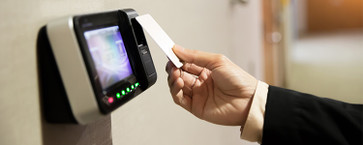Is It Time to Switch to Contactless Cards?
Even before the COVID-19 pandemic began marching across the U.S., many companies and institutions had recognized the benefits of using contactless smart cards or badges. Rather than being swiped or inserted into a card reader, cards with radio frequency identification (RFID) can be waved in front of a device to grant access to a building or prove identification.
Although the technology dates back to World War II, it has evolved significantly over time. Today, the sophistication of RFID badges has grown to allow them to play several roles. In addition to serving as a form of photo identification and ensuring secure access to buildings, the cards provide information about the cardholder’s movements and can help track their whereabouts.
How? Because every time the card is used, it leaves a footprint via technology. The access device, or reader, will record the action in a database, making note of the date, time and what door was opened. Should a security breach occur, or vital information goes missing, a security team can access the database and discover which individuals were in a room or area at the time the event occurred.
Unlike cards that must be scanned or swiped, contactless RFID cards only require the user to get close enough to a card reader to pick up a signal. This also contributes to their longevity; since the cards don’t make physical contact with a card reader, there’s less friction for both the card and the reader, meaning both will last longer.
The Growing Popularity of Contactless Cards
The growth of the RFID or contactless cards market has been largely driven by the government and healthcare sectors, both of which need an affordable but effective way to manage large numbers of people passing through their doors. A report released by Research and Markets in April projected that the smart badge market would grow from $21.1 billion this year to $33.8 billion by 2025 — and that’s just in North America, with the U.S. making up the lion’s share of that business. And now, in an age of concerns about COVID-19 and the rapid spread of germs, contactless cards are rapidly gaining even greater appeal.
The growth of smart cards has come from the many benefits to using them, including their efficiency, ease of use and cost-effectiveness. But there’s also widespread belief they could also help when it comes to limiting the spread of germs.
Can Cards Help Defend Against Coronavirus?
Because there’s still so much that isn’t known about the coronavirus and how it spreads, there’s an abundance of caution about one or more people sharing contact with certain objects — and that includes items made out of plastic and stainless steel. Employees or visitors who might once have thought nothing of punching a button to gain entry to a building or room now may be more reluctant to risk the spread of germs.
And that’s where contactless cards can help. The less a card makes contact with other surfaces (or with human hands), the less likely it is to be able to help spread the virus.
Already, as the coronavirus has spread, the use of contactless payments has skyrocketed as Americans avoid cash and look for ways to have less physical interaction during transactions. Not only does the use of a contactless card for payment minimize how many surfaces (or hands) the card touches, but it’s also faster and more efficient. The same is true of contactless cards in the workplace. When implemented into ID badges, contactless technology allows the necessary mobility and access for workers while giving them greater peace of mind that they’re avoiding the risk of spreading or picking up germs.
Providing Protection on the Front Lines
But avoiding contact and spread of germs via ID badges is just part of what contactless cards can do. In a healthcare environment, they could also prove critical in helping contain the spread. They can gather valuable information on each individual’s activity and the interactions they’ve had. In the event that an employee tests positive for the virus, the hospital can use the data from the card to see where they have been and who they might have come in contact with.
Additionally, the use of such badges ensures that only those who are authorized to be in certain areas will be able to gain access. In a time when it is critical for access to be more closely monitored, this provides a simple and effective way to ensure proper entry.
Taking Control of the Situation
If you have an ongoing, changing need for badges, you could consider printing your contactless ID badges on-site. This allows you to create additional cards as needed, and there are several options for card printers. RFID printers are built with an encoder that uses radio frequency transmission to write the data specific to each card. It also can do everything a regular printer can do, such as print graphic elements like text, photos and logos.
Even before the global pandemic, contactless cards made sense for a growing number of industries. Now, they could be part of a well-planned long-term strategy.



